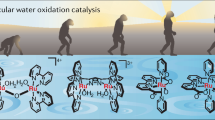Abstract
Motivated by previous experiences in identifying active reaction zones on plant pheophytins of the so-called semi-derivative morphology, for the catalytic decomposition of hydrogen gas, this current research aimed for similarly suggestive sites within DNA base pairs which exist in all living matters. Verified by the 1st-principle quantum mechanical simulations and subsequent wet and dry hydrogen fuel cell experiments, the feasibility of room-temperature DNA-catalyzed hydrogen oxidation reaction was unambiguously established. This implies that very low-cost DNA-catalyzed fuel cells, which contain no expensive, CO-sensitive platinum on the negative electrode side, can be put to work under room condition and thus might be practically available in every household in the very near future.








Similar content being viewed by others
Notes
A quantum mechanical simulation code of Accelry’s Material Studio to simulate physical, chemical, and optical properties of molecules and compounds based on the density functional theory (DFT). In it, generalized gradient approximation (GGA) PW91 scheme for exchange correlation, and numerical atomic orbital DND basis set, self-consistent field (SCF) tolerance of 1 × 10−5 eV were employed. During the geometry optimization for minimum Hamiltonian calculations, the approach of Partial Structural Constraint Path Minimization (PSCPM) was adopted.
References
Huang, J.L., Lai, W.B., Liao, C.P., Yeh, L.S.: A suspected derivative morphology for pheophytin and the enhanced hydrogen decomposition it caused. Opt. Quant. Electron. 48, 469 (2016)
Kadish, K.M., Smith, K.M., Guilard, R.: Handbook of Porphyrin Science: With Applications to Chemistry, Physics, Materials Science, Engineering, Biology and Medicine, pp. 1–35. World Scientific Publishing Company, Danvers (2014)
Nordell, K.J., Jackelen, A.-M.L., Michael Condren, S., Lisensky, G.C., Ellis, A.B.: DNA extraction from animal and plant tissues. J. Chem. Educ. 76, 400A–400B (1999)
Rittman, M., Hoffmann, S.V., Gilroy, E., Hicks, M.R., Finkenstadt, B., Rodger, A.: Probing the structure of long DNA molecules in solution using synchrotron radiation linear dichroism. Phys. Chem. Chem. Phys. 14, 353–366 (2012)
Wieckowski, A., Norskov, J.: Fuel Cell Science: Theory, Fundamentals, and Biocatalysis, pp. 489–510. Wiley, Hoboken (2010)
Acknowledgments
The authors acknowledge the full financial support of ARBL for this research work.
Author information
Authors and Affiliations
Corresponding author
Additional information
This article is part of the Topical Collection on Photonic Science and Engineering on the Micro/Nano Scale.
Guest Edited by Yen-Hsun Su, Lei Liu, Yiting Yu and Yikun Liu.
Rights and permissions
About this article
Cite this article
Lai, WB., Huang, JL., Liao, C. et al. Room-temperature DNA-catalyzed hydrogen fuel cell. Opt Quant Electron 48, 486 (2016). https://doi.org/10.1007/s11082-016-0749-x
Received:
Accepted:
Published:
DOI: https://doi.org/10.1007/s11082-016-0749-x




